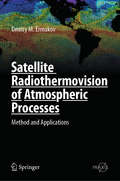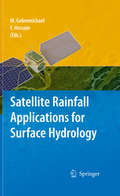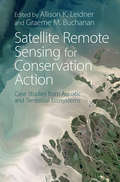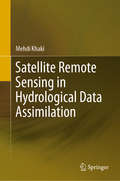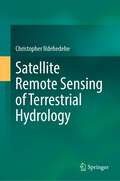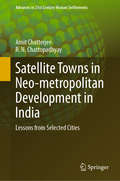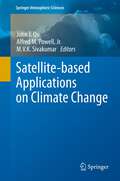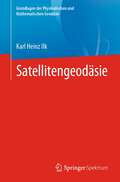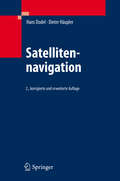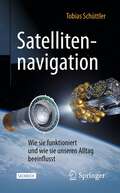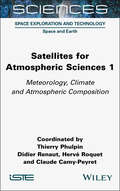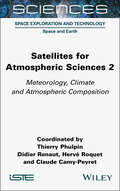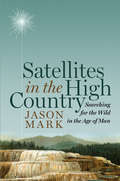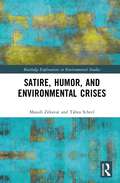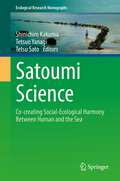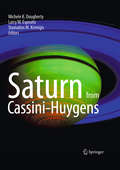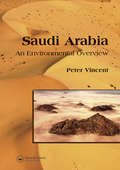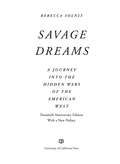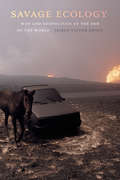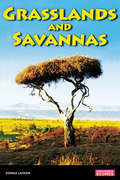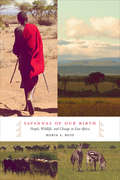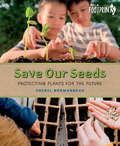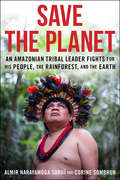- Table View
- List View
Satellite Radiothermovision of Atmospheric Processes: Method and Applications (Springer Praxis Books)
by Dmitry M. ErmakovThis book summarizes the author’s research resulted in developing the satellite radiothermovision approach which allows retrieving dynamical and energy characteristics of atmospheric mesoscale and synoptic-scale processes based on a close scheme of satellite passive radiometry data processing. The book introduces new applications of the satellite passive microwave observations to detailed systematic study of tropical cyclones’ evolution, climatology and characteristics of atmospheric river, parameters of global atmospheric circulation and their variations on climatically significant scales. The results presented in the book demonstrate a clear relation between the convergence/divergence of latent heat from the lower atmosphere to the center of tropical cyclone with variations of its intensity and provide a better insight into the tropical cyclone dynamical energy balance based on remote data.
Satellite Rainfall Applications for Surface Hydrology
by Mekonnen Gebremichael Faisal HossainWhile there are a growing number of high-resolution space-based systems for measuring precipitation, instances of the use of these products for surface hydrology are rare. This book, which covers both scientific and practical matters, aims to change that. With contributions from a panel of researchers from a wide range of fields, the chapters focus on evaluating the potential, utility and application of high resolution satellite precipitation products in relation to surface hydrology. Focusing on the way the algorithms for the precipitation products evolved, the accuracy assessment of those products in different regions of the world, and the application of the precipitation products to various decision support systems, the book is at the interface between satellite rainfall and surface hydrologic applications. It dwells on issues that are of concern at hydrologic scales of application. In doing so, it provides very useful information to practitioners, researchers and graduate students who need to explore the latest on satellite precipitation products for various hydrological purposes. Crucially, the book provides examples of real-world applications of satellite rainfall products in operational hydrology and real-time decision-making. This enables readers to understand the potential of satellite rainfall products for practical applications ranging from agricultural/crop monitoring to flood and landslide detection in developing countries.
Satellite Remote Sensing for Conservation Action: Case Studies from Aquatic and Terrestrial Ecosystems
by Allison K. Leidner Graeme M. BuchananSatellite remote sensing presents an amazing opportunity to inform biodiversity conservation by inexpensively gathering repeated monitoring information for vast areas of the Earth. However, these observations first need processing and interpretation if they are to inform conservation action. Through a series of case studies, this book presents detailed examples of the application of satellite remote sensing, covering both aquatic and terrestrial ecosystems, to conservation. The authors describe how collaboration between the remote sensing and conservation communities makes satellite data functional for operational conservation, and provide concrete examples of the lessons learned in addition to the scientific details. The editors, one at NASA and the other at a conservation NGO, have brought together leading researchers in conservation remote sensing to share their experiences from project development through to application, and emphasise the human side of these projects.
Satellite Remote Sensing in Hydrological Data Assimilation
by Mehdi KhakiThis book presents the fundamentals of data assimilation and reviews the application of satellite remote sensing in hydrological data assimilation. Although hydrological models are valuable tools to monitor and understand global and regional water cycles, they are subject to various sources of errors. Satellite remote sensing data provides a great opportunity to improve the performance of models through data assimilation.
Satellite Remote Sensing of Terrestrial Hydrology
by Christopher NdehedeheThis book highlights several opportunities that exist in satellite remote sensing of large-scale terrestrial hydrology. It lays bare the novel concept of remote sensing hydrology and demonstrates key applications of advance satellite technology and new methods in advancing our fundamental understanding of environmental systems. This includes, using state-of-the-art satellite hydrology missions like the Gravity Recovery and Climate Experiment and other multi-mission satellite systems as important tools that underpin water resources planning and accounting. This book discusses and demonstrates how the efficacy, simplicity, and sophistication in novel computing platforms for big earth observation data can help facilitate environmental monitoring and improve contemporary understanding of climate change impacts on freshwater resources. It also provides opportunities for practitioners and relevant government agencies to leverage satellite-based information in a transdisciplinary context to address several environmental issues affecting society. This book provides a general framework and highlights methods to help improve our understanding of hydrological processes and impact analysis from extreme events (e.g., droughts, floods) and climate change.
Satellite Towns in Neo-metropolitan Development in India: Lessons from Selected Cities (Advances in 21st Century Human Settlements)
by Amit Chatterjee R. N. ChattopadhyayThis book discusses population growth and the resultant problems, and highlights the need for immediate action to develop a set of planned satellite towns around Indian megacities to reduce their population densities and activity concentrations. It addresses problems like unplanned spatial expansion, over-concentration of populations, unmanageable situations in industrial growth, and poor traffic management, concluding that only megacities and their satellites, when planned properly, can together mitigate the urgent problem of urban concentration in and around the megacities.Identifying the general problems, the book develops a quantitative and spatially fitting regional allocation model of population and economic activities. It also offers a policy-based planned program of development for the selected megacities in India along with their satellites and fringe areas to ensure a healthy, balanced and prospective urban scenario for India in the coming decades.
Satellite-based Applications on Climate Change
by Alfred Powell John Qu M.V.K. SivakumarClimate and other environmental changes are drawing unprecedented concern and attention from national governments, international organizations and local communities. Global warming has left noticeable impacts on the environment and the ecosystems it supports (including humans), and has important implications for sustainable economic and social development in the future. Satellite observations of climate and environmental change have become an increasingly important tool in recent years in helping to shape the response of international communities to this critical global challenge. The book presents the latest advances in satellite-based remote sensing of the Earth's environment - ranging from applications in climate and atmospheric science to hydrology, oceanography, hydrology, geomorphology, ecology and fire studies. Introductory chapters also cover key technical aspects such as instrumentation, calibration, data analysis, and GIS tools for decision-making.
Satellitengeodäsie (Grundlagen der Physikalischen und Mathematischen Geodäsie)
by Karl Heinz IlkDieses Lehrbuch aus der Reihe „Grundlagen der Physikalischen und Mathematischen Geodäsie“ gibt einen Einblick in die geodätische Nutzung künstlicher Erdsatelliten. Die heutzutage erfolgreichsten Beobachtungs- und Analysemethoden zur Erforschung des Systems Erde werden unter dem Sammelbegriff "Satellitengeodäsie" zusammengefasst. In einem einleitenden Abschnitt werden die Theorie der Satellitenbewegung und die Störungsgleichungen der klassischen Bahnelemente betrachtet. Darauf bauen die verschiedenen Anwendungsmöglichkeiten der geodätischen Nutzung künstlicher Erdsatelliten auf und insbesondere die speziellen Methoden der Analyse langer Bahnen zur Bestimmung des Gravitationsfeldes. Vor allem werden die sog. In-Situ-Methoden der Gravitationsfeldbestimmung mit Hilfe künstlicher Erdsatelliten erläutert, die mit den Anwendungen der Satelliten-Gravitations-Gradiometrie und der Ausmessung des statischen und zeitveränderlichen Gravitationsfeldes mit Hilfe des Satellite-to-Satellite-Trackings zu spektakulären Ergebnissen geführt haben. Somit haben die Leser die Möglichkeit, die Verfahren anschaulich zu begreifen, die sich in den letzten Jahrzehnten bewährt haben.
Satellitennavigation
by Hans Dodel Dieter HäuplerDie Ortung und Navigation mit Hilfe von Satelliten steht an einem Wendepunkt. Mit dem europäischen Satellitennavigationssystem GALILEO ist die Entscheidung für ein eigenes europäisches Navigationssystem gefallen, das neue Maßstäbe setzt und der europäischen Wirtschaft nachhaltige Impulse geben kann. Wie funktioniert GALILEO? Warum brauchen wir dieses System? Welche Anwendungen werden damit möglich? Diese Fragen beantwortet das Buch und stellt den aktuellen Wissensstand zu diesem Thema dar, einschließlich der mathematischen Grundlagen.
Satellitennavigation: Wie sie funktioniert und wie sie unseren Alltag beeinflusst (Technik im Fokus)
by Tobias SchüttlerFaszination Satellitennavigation – welche Rolle spielt sie im täglichen Leben? Wie funktioniert diese Technik? Was wäre, wenn GPS abgeschaltet würde? Und wie steht es um das europäische Galileo-System?In den vergangenen 20 Jahren hat sich die Satellitennavigation von einer anfangs rein militärischen Technologie hin zur vollkommen selbstverständlich genutzten Alltagstechnik entwickelt. Die Bandbreite reicht vom Navigationsgerät im Auto über Smartphones und kleine Empfänger für Outdoorsportler bis hin zu hochgenauen Spezialgeräten zum Zwecke der Landvermessung. Der Autor erläutert die im Prinzip sehr einfache Funktionsweise, welche jedoch in der konkreten Umsetzung modernste Methoden der Nachrichten- und Elektrotechnik, der Geographie und der Physik erfordert. In der zweiten Auflage wird verstärkt auf das europäische Galileo-System eingegangen und dessen aktueller Ausbaustand beschrieben.
Satellites for Atmospheric Sciences 1: Meteorology, Climate and Atmospheric Composition
by Claude Camy-Peyret Thierry Phulpin Didier Renaut Hervé RoquetHow can atmospheric variables such as temperature, wind, rain and ozone be measured by satellites? How are these measurements taken and what has been learned since the first measurements in the 1970s? What data are currently available and what data are expected in the future? The first volume of this encyclopedic book answers these questions by reporting the history of satellite meteorology and addresses how national and international agencies define coordinated programs to cover user needs. It also presents the principles of satellite remote sensing to deliver products suited to user requirements. This book is completed by a glossary and appendices with a list of supporting instruments already in use.
Satellites for Atmospheric Sciences 2: Meteorology, Climate and Atmospheric Composition
by Claude Camy-Peyret Thierry Phulpin Didier Renaut Hervé RoquetHow can atmospheric variables such as temperature, wind, rain and ozone be measured by satellites? How are these measurements taken and what has been learned since the first measurements in the 1970s? What data are currently available and what data are expected in the future? The second volume of this encyclopedic book presents each field of application – meteorology, atmospheric composition and climate – with its main aims as well as the specific areas which can be addressed through the use of satellite remote sensing. This book presents the satellite products used for operational purposes as well as those that allow for the advancement of scientific knowledge. The instruments that are at their origin are described, as well as the processing, delivery times and the knowledge they provide. This book is completed by a glossary and appendices with a list of supporting instruments already in use.
Satellites in the High Country: Searching for the Wild in the Age of Man
by Jason MarkIn New Mexico's Gila Wilderness, 106 Mexican gray wolves may be some of the most monitored wildlife on the planet. Collared, microchipped, and transported by helicopter, the wolves are protected and confined in an attempt to appease ranchers and conservationists alike. Once a symbol of the wild, these wolves have come to illustrate the demise of wilderness in this Human Age, where man's efforts shape life in even the most remote corners of the earth. And yet, the howl of an unregistered wolf--half of a rogue pair--splits the night. If you know where to look, you'll find that much remains untamed, and even today, wildness can remain a touchstone for our relationship with the rest of nature. In Satellites in the High Country, journalist and adventurer Jason Mark travels beyond the bright lights and certainties of our cities to seek wildness wherever it survives. In California's Point Reyes National Seashore, a battle over oyster farming and designated wilderness pits former allies against one another, as locals wonder whether wilderness should be untouched, farmed, or something in between. In Washington's Cascade Mountains, a modern-day wild woman and her students learn to tan hides and start fires without matches, attempting to connect with a primal past out of reach for the rest of society. And in Colorado's High Country, dark skies and clear air reveal a breathtaking expanse of stars, flawed only by the arc of a satellite passing--beauty interrupted by the traffic of a million conversations. These expeditions to the edges of civilization's grid show us that, although our notions of pristine nature may be shattering, the mystery of the wild still exists -- and in fact, it is more crucial than ever. But wildness is wily as a coyote: you have to be willing to track it to understand the least thing about it. Satellites in the High Country is an epic journey on the trail of the wild, a poetic and incisive exploration of its meaning and enduring power in our Human Age.
Satire, Humor, and Environmental Crises (Routledge Explorations in Environmental Studies)
by Tabea Scheel Massih ZekavatSatire, Humor, and Environmental Crises explores how satire and humor can be employed to address and mitigate ecological crises at individual and collective levels. Besides scientific and technological endeavors, solutions to ecological crises must entail social and communicative reform to persuade citizens, corporations, organizations, and policymakers to adopt more sustainable lifestyles and policies. This monograph reassesses environmental behavior and messaging and explores the promises of humorous and satiric communication therein. It draws upon a solid and interdisciplinary theoretical foundation to explicate the individual, social, and ecospheric determinants of behavior. Creative works of popular culture across various modes of expression, including The Simpsons, Last Week Tonight with John Oliver, and The New Yorker cartoons, are examined to illustrate the strong if underappreciated relationship between humor and the environment. This is followed by a discussion of the instruments and methodological subtleties involved in measuring the impacts of humor and satire in environmental advocacy for the purpose of conducting empirical research. More broadly, the book aspires to participate in urgent cultural and political discussions about how we can evaluate and intervene in the full diversity of environmental crises, engage a broad set of internal and external partners and stakeholders, and develop models for positive social and environmental transformations. This book will be of great interest to students and scholars interested in environmental humanities, communication science, psychology, and critical humor studies. It can further benefit environmental activists, policymakers, NGOs, and campaign organizers.
Satoumi Science: Co-creating Social-Ecological Harmony Between Human and the Sea (Ecological Research Monographs)
by Tetsuo Yanagi Tetsu Sato Shinichiro KakumaThis book guides readers to the new concept of “Satoumi” and explains how its practice works to solve challenges in complex social-ecological systems of coastal areas. The book describes the significance of Satoumi Science as a transdisciplinary process. It starts with introducing the definition of Satoumi, highlights the important distinction between active measures (direct actions to improve ecosystem functions and services) and passive measures (a variety of management activities), and presents the concept of Integrated Local Environmental Knowledge (ILEK) as a knowledge base for Satoumi activities. It also introduces residential researchers and bilateral knowledge translators as the key actors of Satoumi co-creation through the transdisciplinary processes. The concept of Satoumi goes beyond the idea of protecting pristine nature by eliminating humans. It is about creating coastal environments where humans closely connect with the sea, which leads to the effective conservation and sustainable management of various natural resources and ecosystem services. This book will be of high interest to managers, governments, environmental groups, and the research community. Chapters cover current and emerging concerns, such as over- and under-use of natural resources, restoration of damaged ecosystems, and co-creation of new relations between humans and coastal seas, from transdisciplinary approaches to tackle with complex and 'wicked' challenges of coastal social-ecological systems.
Saturn from Cassini-Huygens
by Michele Dougherty Stamatios Krimigis Larry EspositoThis book comprehensively reviews our current knowledge of Saturn featuring the latest results obtained by the Cassini-Huygens mission. A global author team addresses the planet's origin and evolution, internal structure, composition and chemistry, the atmosphere and ionosphere, the magnetosphere, as well as its ring system. Furthermore, Saturn's icy satellites are discussed. The book closes with an outlook beyond the Cassini-Huygens mission. Colorfully illustrated, this large size book will serve as an authoritative reference to researchers as well as an introduction for students.
Saudi Arabia: An Environmental Overview
by Peter VincentA comprehensive overview of Saudi Arabia‘s environment, this volume is a unique and authoritative text on the geological and environmental aspects of Saudi Arabia, a country about which little is known by the outside world. Saudi Arabia is a fascinating country with a long tradition of environmental awareness and sensitivity, pitted again
Savage Dreams
by Rebecca Solnit"A beautiful, absorbing, tragic book."--Larry McMurtryIn 1851, a war began in what would become Yosemite National Park, a war against the indigenous inhabitants. A century later-in 1951-and a hundred and fifty miles away, another war began when the U.S. government started setting off nuclear bombs at the Nevada Test Site. It was called a nuclear testing program, but functioned as a war against the land and people of the Great Basin.In this foundational book of landscape theory and environmental thinking, Rebecca Solnit explores our national Eden and Armageddon and offers a pathbreaking history of the west, focusing on the relationship between culture and its implementation as politics. In a new preface, she considers the continuities and changes of these invisible wars in the context of our current climate change crisis, and reveals how the long arm of these histories continue to inspire her writing and hope.
Savage Ecology: War and Geopolitics at the End of the World
by Jairus Victor GroveJairus Victor Grove contends that we live in a world made by war. In Savage Ecology he offers an ecological theory of geopolitics that argues that contemporary global crises are better understood when considered within the larger history of international politics. Infusing international relations with the theoretical interventions of fields ranging from new materialism to political theory, Grove shows how political violence is the principal force behind climate change, mass extinction, slavery, genocide, extractive capitalism, and other catastrophes. Grove analyzes a variety of subjects—from improvised explosive devices and drones to artificial intelligence and brain science—to outline how geopolitics is the violent pursuit of a way of living that comes at the expense of others. Pointing out that much of the damage being done to the earth and its inhabitants stems from colonialism, Grove suggests that the Anthropocene may be better described by the term Eurocene. The key to changing the planet's trajectory, Grove proposes, begins by acknowledging both the earth-shaping force of geopolitical violence and the demands apocalypses make for fashioning new ways of living.
Savage Tsunamis
by Michael PortmanIntroduces tsunamis, describing how they are formed, the damages that result from them, and the devices that are being developed to predict them.
Savannas and Grasslands
by Donna LathamInvestigating a variety of biomes and today's natural and human threats to their preservation, this interactive series challenges young readers to look at how their own actions influence the planet's health. Four distinct environments are explored in detail, showcasing the assortment of plants and animals that inhabit these outdoor communities as well as how they have adapted to their surroundings. Offering fascinating facts on each ecosystem along with vocabulary-building sidebars, these guides show budding scientists how they can contribute towards ongoing conservation efforts. Exploring the vast biome of the savannas and grasslands, this reference highlights the problems of disease and invasive species, outlining how this beautiful setting across the world can be saved.
Savannas of Our Birth
by Robin S. ReidThis book tells the sweeping story of the role that East African savannas played in human evolution, how people, livestock, and wildlife interact in the region today, and how these relationships might shift as the climate warms, the world globalizes, and human populations grow. Our ancient human ancestors were nurtured by African savannas, which today support pastoral peoples and the last remnants of great Pleistocene herds of large mammals. Why has this wildlife thrived best where they live side-by-side with humans? Ecologist Robin S. Reid delves into the evidence to find that herding is often compatible with wildlife, and that pastoral land use sometimes enriches savanna landscapes and encourages biodiversity. Her balanced, scientific, and accessible examination of the current state of the relationships among the region's wildlife and people holds critical lessons for the future of conservation around the world.
Save Our Seeds: Protecting Plants for the Future (Orca Footprints #31)
by Sheryl NormandeauKey Selling Points Learning about the importance of seeds and how to save and conserve them for the future is imperative to sustaining healthy life on the planet. Introduces young readers to STEM concepts, such as pollination, biodiversity, healthy ecosystems, food security, the climate crisis, GMO food and genetic engineering. Gives young readers the practical tools to take action to save seeds in their own lives and communities. The author is a certified master gardener and works with various gardening organizations in Alberta. She has a background in horticulture and urban agriculture and has written a number of nonfiction books for adults and kids.
Save The Planet: An Amazonian Tribal Leader Fights for His People, The Rainforest, and The Earth
by Corine Sombrun Julia Grawemeyer Almir Narayamoga SuruiAlmir Sarayamoga Suruí, the Amazonian tribal chieftain of the indigenous Suruí people, is a leader in the fight to save the rainforest not only for the preservation of his land and people, but for the Earth's and humanity's survival as well. Joining forces with such high-tech corporations as Apple and Google Earth, Suruí has become a guardian of his people and a global activist, despite death threats and million dollar bounties on his head. A recipient of the Global Citizen Award in 2012, Suruí has calculated the direct cost of the loss of our rainforests—"the lungs of the Earth"—in terms of the total amount of Co2 that their destruction would release into the atmosphere, and the monetary loss that this would entail, and by using this carbon deficit formula, has leased access to pharmaceutical and cosmetic companies who have joined him in the stewardship of these endangered lands, their flora, fauna, and people.
Save the Animals! (Saving Our Planet)
by Mary BooneIntroduces early readers to environmentalist concepts including deforestation, animals and their habitats, and conservation, and what they can do to help the environment. Features real-life examples of kids who have made a difference.
